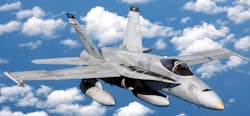Industry asked to weigh-in on Navy plan to upgrade combat aircraft avionics software to enhance pilot safety
PATUXENT RIVER NAS, Md. – U.S. Navy avionics experts are asking industry to weigh-in on a plan to upgrade flight-control software in Navy attack jets to reduce the risk of pilots crashing into the ground on difficult missions.
Officials of the Naval Air Systems Command at Patuxent River Naval Air Station, Md., issued a request for information on Wednesday (223201-21_AGCA) for the upcoming Automatic Ground Collision Avoidance System (Auto-GCAS) Flight Control Computer (FCC) Upgrade.
Navy officials want to compile a sense-of-the-industry on a plan to upgrade the avionics of the Navy Boeing F/A-18C/D light-attack bomber to enhance the aircraft's ability to prevent controlled flight into terrain when the pilot is fixated on a target during an attack dive; spatially disoriented; loses consciousness; or suffers degraded abilities due to oxygen deprivation.
The F/A-18C/D light-attack bomber has a quad-redundant digital fly-by-wire flight-control system that converts pilot and aircraft inputs to flight control actuator commands from surface actuators, air data sensors, pilot controls and displays, software, and the quad-channel flight control electronic set (FCES) subsystem.
The flight-control system provides overall control of the F/A-18C/D aircraft and controls flight, redundancy management, autopilot, input/output processing, system monitors, and built-in-test.
The planned upgrade will include the ability to translate the pull vector from the digital map computer into flight control movements, provide status to the mission computer, and perform system integrity checks.
The automatic ground collision avoidance system project would be a change to the software in the aircraft's digital map computer, and combines with the existing terrain avoidance warning system to create the automatic terrain avoidance and warning system.
Software updates are necessary in the mission computer and digital map computer. The flight control computer program also will need updating. The company that might win a contract for this project will update and test the flight control computer program.
The automatic ground collision avoidance system is to provide a safety backup that automatically recovers the aircraft from an impending crash using digital terrain elevation data as a reference for ground elevation.
The system will compare digital terrain elevation to flight parameters to generate a warning and initiate automatic recovery if the pilot does not take action. The system will generate visual warnings/advisories and aural alerts to alert the aircrew when needed.
The system will enable the pilot manually to initiate a recovery that returns the aircraft to straight and level flight.
Navy experts are looking for a company to modify the existing flight control computer program with new functionality to support automatic ground collision avoidance.
There are several key challenges that the contractor must face. While Navy experts will provide source code for the flight control computer program, they cannot provide the build tools that actually generate the executable program.
The F/A-18C/D aircraft uses the General Electric MCP 701E processor for flight control, which has no significant commercial use outside the F-18C/D application, and has proprietary build tools.
Navy officials want to ensure that industry understands the content of this request for information by conducting one-on-one teleconferences with prime contractors who are interested.
Email requests for teleconferences no later than 1 June 2021 to the Navy's Luis Ferrer at [email protected] and Cassandra Spence at [email protected].
More information is online at https://beta.sam.gov/opp/677b3d452a1d448bbeb45a4c5c82369a/view.

John Keller | Editor-in-Chief
John Keller is the Editor-in-Chief, Military & Aerospace Electronics Magazine--provides extensive coverage and analysis of enabling electronics and optoelectronic technologies in military, space and commercial aviation applications. John has been a member of the Military & Aerospace Electronics staff since 1989 and chief editor since 1995.

